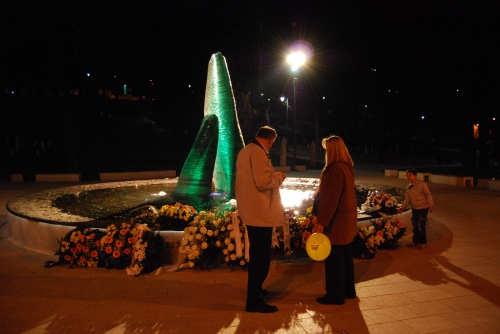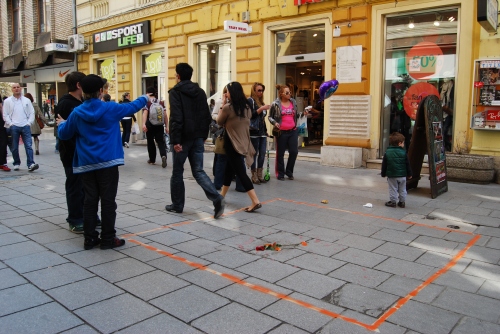This week two historical dates were commemorated in Sarajevo: the day of the liberation of the city in the Second World War and the beginning of the siege of Sarajevo, in 1992.
 Photo: the Croat representative on the collective Bosnian presidency, Zeljko Komsic, places a wreath of the Eternal Flame.
Photo: the Croat representative on the collective Bosnian presidency, Zeljko Komsic, places a wreath of the Eternal Flame.
The commemorations started with the deposition of flowers in memorial monuments. Flower wreaths were placed in the Eternal Flame, which marks the victory over fascism in the Second World War, but also at the Cemetery of Kovaci, the mezarja (Muslim cemetery) dedicated to the Shehid, the fallen soldiers of Muslim faith. Flowers were also placed at the statue of Tito at the University campus (where the JNA barracks used to be), and at the bust of Vladimir Peric “Valter”,a partisan who became a mythical figure in Sarajevo; at the Vrbanja bridge in Grbavica where on the 6 of April 1992 two young women, Suada Dilberovic and Olga Sucic, were killed when Serb forces started shooting at a peace demonstation- the bridge was renamed after them; at the Partisan memorial park of Vraca; at the Old Jewish cemetery; and at the monument dedicated to the children of Sarajevo who were killed during the siege.
The commemoration of both wars was simultaneous not only because of the coincidence of dates, but also because of the coincidence of places: both the memorial park of Vraca and the Jewish Cemetery were used as launching pads from which the Serb forces targeted the city. The connection between both wars is also made through the invocation of anti-fascism. Such approach, while establishing a connection between both wars, also allows to identify the nature of the recent war as a new episode of the confrontation between fascism and anti-fascism, and thus ‘de-ethnicise it’. But such connection is far from being consensual, and reflects the ideological divide existent in Bosnian society. Not everyone views the communist regime only through the perspective of an heroic anti-fascist struggle. Thus not everyone who went to the Mezarija in Kovaci went also to the Vijecna Vatra, and only people affiliated with SDP, the social democratic party, went to Tito and Valter’s statues.
Only a few people attend such institutional ceremonies, mostly people in official positions and NGO activists. Most Sarajevans are rather indifferent to them, and simply spend this city holiday enjoying Spring. This does not mean that they are unaware to the meaning of such date. On the contrary. We are speaking about living memory here. Those that are old enough have their own war experience to cope with, including, for the elderly population, the memory of both wars, and for the younger ones the legacy war is present both through their family’s history and through the lack of perspectives towards the future, a consequence of the social and political environment that emerged out of the war.
 Photo: the memorial dedicated to the children of Sarajevo killed during the war.
Photo: the memorial dedicated to the children of Sarajevo killed during the war.
This larger mass of people, who does not actively participates in commemorations are nevertheless interpellated by the existence of the memorials on the public space, on the streets which they walk through, on the squares where they enjoy their coffee or their beer, and the flowers remind them that there is something to commemorate. This is why different political forces try to place their own imprint into these memorial sites, so that they become associated with what is there to be commemorated and through that memory assert their legitimacy.
But there is more to memory than politics, and that is why, of all the forms to commemorate the war that took place in Sarajevo on this 6 of April, the one that most challenging was an anonymous initiative: on the Ferhadija street, formerly Vasa Miskin’s street, on the exact place where in 27 May 1992 the bomb that killed 20 people hit the floor, in what became known as the bread line massacre, someone drew a square with tape, and painted it orange, and on the centre, where the impact hole is, a red rose was placed.
I sat on some door steps for a while, watching people’s reactions. Some walked through without even noticing, but most people tried to avoid stepping over it as much as they could, contorting it when they could, or bouncing sideways to in extremis avoid smashing the flower. This is the most crowded street of Sarajevo, and it was not easy to see it before getting to its spot.
Some people stopped and looked at the memorial plaque placed at the wall of the closest building, others did not stop, but through their face expressions and gestures acknowledged the meaning of this rather precarious, ephemeral. Like memory, and like life itself.



You must be logged in to post a comment.